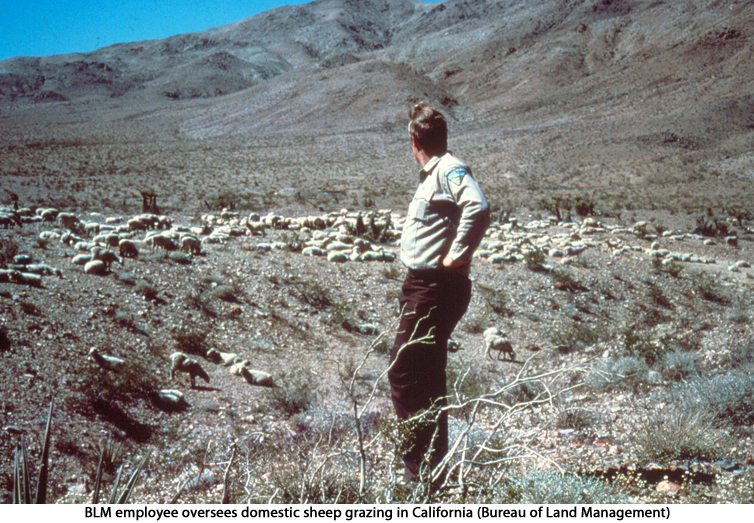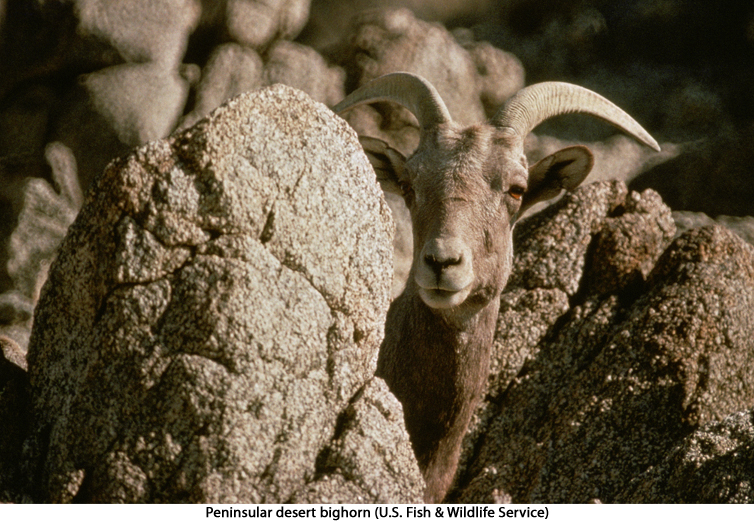FEDERAL AGENCY TRENDS
U.S. Forest Service
While controversy has erupted over restricting domestic sheep grazing in the Sierra Nevada to protect bighorns, some of the most controversial bighorn-domestic sheep management policies have involved a series of court battles and legislation conflicts centered on Idaho and Hells Canyon (Reiterman 2005; Barker 2011a). Many of these relate to the U.S. Forest Service (USFS) (Barker 2011a).

In 1999, regarding the disease issue, USFS representative Melanie Woolever stated: “There’s a lot of resistance by the leadership of our agency to address it. The livestock industry has traditional power within our agency and in the Legislature in the states in the West. They’re very effective and it’s been one of those things that has been pushed aside unless the situation was critical” (Hurley et al. 1999, 287). She added that: “We’re not wanting to put the livestock industry out of business. They own base property that we’d rather see in their hands than condos or 5-40 acre ranchettes” (Hurley et al. 1999, 287). While the USFS has not always confronted the bighorn-domestic sheep disease issue as directly as other agencies, in 2001, they released “A Process for Finding Management Solutions to the Incompatibility Between Domestic and Bighorn Sheep.” This is an informative 64-page document authored by agency bighorn biologists Tim Schommer and Melanie Woolever (USFS 2001).
Despite reluctance, the USFS was forced to directly confront the bighorn-domestic sheep disease issue when environmental advocacy groups sued them in the 1990s and numerous times afterward for failing to protect bighorns from domestic sheep (NWF 1995; Hoffman 2007). This litigation focused on Hells Canyon and the Payette National Forest in Idaho (Barker 2011a). Lawsuits eventually led to significant agency research, risk analysis, and the controversial Payette decision limiting domestic sheep grazing in the area (Barker 2011; Pramuk 2010). However, implementation of that decision was delayed in 2012 because of the USFS’s interpretation of a Congressional rider Idaho Representative Mike Simpson tacked onto the annual Interior and Environment Appropriations bill in 2011 (Barker 2011b; U.S. Congress 2011; Pramuk 2012). Later in 2012, a judge overruled the USFS delay of the Payette decision (Cole 2012).
Bureau of Land Management
The Bureau of Land Management (BLM) directly addressed the bighorn-domestic sheep disease issue on an agency-wide scale earlier than the USFS. In 1989, the BLM asked the technical staff of the Desert Bighorn Council (DBC) to develop guidelines for domestic sheep management in bighorn ranges (BLM 1995b). Released in 1990, the initial DBC/BLM guidelines were targeted at desert bighorns. They were also specific, involved four main recommendations, and based on science (DBC Technical Staff 1990).

In 1992, agencies rewrote the 1990 guidelines in a collaborative process involving the BLM, USFS, DBC, Wild Sheep Foundation, American Sheep Institute, wildlife veterinarians, and the Western Association of Fish and Wildlife Agencies (DBC Technical Staff 1990; BLM 1995b). The 1992 guidelines generally retain the 1990 recommendations but are augmented and include caveats acknowledging evidence gaps and the importance of the disease issue. The 1992 document also involves ten main recommendations and a clause about the domestic sheep industry being held harmless if bighorn disease occurs when special agreements are in place. Additionally, the 1992 guidelines feature special recommendations for desert bighorns and a statement saying the guidelines will be reviewed every three years (BLM 1995b). The 1992 guidelines declare that they “should be followed in current and future bighorn/domestic sheep use areas” (BLM 1995b, 32).
In 1998, in collaboration with bighorn and domestic sheep experts, the BLM revised the 1992 guidelines (BLM 1999). The BLM says the 1998 guidelines “should be followed whenever reintroductions, transplants, or augmentations of wild sheep populations, or proposed changes in a livestock grazing permit on BLM administered lands are being considered. . . .” (BLM 1999, 95). This statement limits circumstances of required guideline use and is not as sweeping as the 1992 guidelines’ reference to following guidelines in “bighorn/domestic sheep use areas” (BLM 1995a, 32).
The 1998 guidelines generally maintain the recommendations and caveats of the 1992 guidelines. However, unlike the 1990 and 1992 guidelines, the 1998 guidelines also address the domestic goat threat (BLM 1999). Another change from the 1992 guidelines is the 1998 document’s more detailed domestic sheep producer indemnity clause. It states:
“. . . the guidelines . . . should be followed in current and future native wild/domestic sheep and goat use areas unless a specific cooperative agreement that includes the State wildlife management agency, the BLM and the livestock permit holder is in place. When such an agreement is in place, the agencies and the livestock permit holder will be held harmless in the event of disease impacting either native wild sheep or domestic sheep and goats” (BLM 1999, 95-96).

Unlike the 1992 guidelines, the 1998 guidelines clearly state enforcement language regarding permitting sheep trailing when separation safeguards are in place (BLM 1999). The 1998 document states that the “BLM must conduct on-site use compliance during trailing to ensure safeguards are observed” (BLM 1999, 96). The BLM says the 1998 guidelines will be reviewed at least every five years (BLM 1999).
As of May 2009, local BLM office managers and state BLM offices had notable discretion regarding bighorn-domestic sheep separation policy (WAFWA 2009). For example, BLM offices in Cody, Lander, and Worland, Wyoming had “fully acknowledged/referenced” (WAFWA 2009, 3) solid recommendations released by the Western Association of Fish and Wildlife agencies while the Headwaters Field Office in Butte, Montana had “completely ignored those recommendations, and continued to permit/advocate/allow conflicting activities in close proximity to occupied [bighorn sheep] habitats” (WAFWA 2009, 3).
U.S. Fish and Wildlife Service
The U.S. Fish and Wildlife Service (USFWS) directly addresses the disease issue in their management of federally endangered bighorn populations (USFWS 2007, 2000). USFWS provides detailed separation recommendations in its 2007 recovery plan for Sierra Nevada bighorns (USFWS 2007). In its 2000 recovery plan for Peninsular desert bighorns, USFWS acknowledges that domestic sheep seriously threaten bighorns, and it mentions prohibiting domestic sheep grazing with 14.5 km (9 mi) of bighorn habitat (USFWS 2000).

REFERENCES
Barker, Rocky. 2011a. Battle for bighorns: Conservationists are struggling to protect bighorn sheep on public lands from disease-carrying livestock. National Wildlife, July. http://www.nwf. org/News-and-Magazines/NationalWildlife/Animals/Archives/2011/ Battle-for-Bighorns .aspx (accessed January 7, 2012).
Barker, Rocky. 2011b. Payette sheep decision delay drops to one year in final spending bil. Idaho Statesman. December 16. http://voices.idahostatesman.com/2011/12/16/rocky barker/payette_sheep_decision_delay_drops_one_year_final_spending_bill (accessed January 9, 2012).
Bureau of Land Management (BLM). 1995a. Appendix C: [1992] Grazing Guidelines for Management of Domestic Sheep in Bighorn Sheep Habitats. In Mountain Sheep Ecosystem Management Strategy in the 11 Western States and Alaska. N.p. ftp://ftp.blm.gov/pub/ blmlibrary/BLMpublications/StrategicPlans/Wildlife/ MountainSheepEcosystem.pdf (accessed May 11, 2012). [govt. doc.]
Bureau of Land Management (BLM). 1995b. Mountain Sheep Ecosystem Management Strategy in the 11 Western States and Alaska. N.p. ftp://ftp.blm.gov/pub/blmlibrary/BLM publications/StrategicPlans/Wildlife/ MountainSheepEcosystem.pdf (accessed May 11, 2012). [govt. doc.]
Bureau of Land Management (BLM). 1999. Attachment 7: 1998 Revised Guidelines for Domestic Sheep and Goat Management in Native Wild Sheep Habitats. In Challis Resource Management Area: Record of Decision and Resource Management Plan. Salmon, ID. http://www.blm.gov/pgdata/etc/medialib/blm/id/plans/challis_rmp.Par.8185.File.dat/ entiredoc_508.pdf (accessed May 12, 2012). [govt. doc.]
Cole, Ken. 2012. A Good Week for Bighorn Sheep in Idaho. Simpson Changes his Tune. (Updated). The Wildlife News. http://www.thewildlifenews.com/2012/06/15/a-good-week-for-bighorn-sheep-in-idaho-simpson-changes-his-tune/ (accessed June 18, 2012).
Desert Bighorn Council Technical Staff. 1990. Guidelines for the management of domestic sheep in the vicinity of desert bighorn habitat. In transactions of DBC’s 34th Annual Meeting, Hermosillo, Sonora, Mexico. April 4-6.
Hoffman, Nathaniel. 2007. Sheep vs. sheep: A legal battle over Hells Canyon grazing could determine the future of wild sheep and sheep ranching across the West. High Country News. October 1. http://www.hcn.org/issues/355/17251 (accessed March 4, 2009).
Hurley, Kevin (moderator), Jon Jorgenson, Helen Schwantje, Craig Foster, Herb Meyer, Amy Fisher, Dave Hacker, Harley Metz, Jim Karpowitz, Melanie Woolever, Dick Weaver, Tim Schommer, Cal McCluskey, Duncan Gilchrist, Jim Bailey, Bonnie Pritchard, Dave Byington, Dave Smith, Bill Foreyt, and Dave Hunter (discussion members). 1999. Open discussion – Are we effectively reducing interaction between domestic and wild sheep? Discussion in proceedings of 2nd North American Wild Sheep Conference, Reno, NV. April 6-9.
National Wildlife Federation (NWF). 1995. NWF goes to court to help protect Hell’s Canyon bighorns from fatal disease. National Wildlife, May-June.
Pramuk, Laura. 2012. Payette N.F. Halts Implementation of Bighorn Sheep Decision at 2011 Stage. USDA Forest Service. http://www.fs.usda.gov/detail/payette/news-events/?cid =STELPRDB535 5841 (accessed March 7, 2012).
Reiterman, Tim. 2005. Bighorn battle heating up – Dispute over grazing rights on public lands, Sheep rancher says: “We’ll be the endangered species.” The Seattle Times. September 21.
U.S. Congress. House. 2011. Consolidated Appropriations Act, 2012. HR 2055. 112th Cong., 1st sess. http://www.gpo.gov/fdsys/pkg/BILLS-112hr2055enr/pdf/BILLS-112hr2055 enr.pdf (accessed January 13, 2012).
U.S. Fish and Wildlife Service (USFWS). 2000. Recovery Plan for Bighorn Sheep in the Peninsular Ranges, California. Portland. http://ecos.fws.gov/docs/recovery_plan/001025. pdf (accessed December 20, 2011). [govt. doc.]
U.S. Fish and Wildlife Service (USFWS). 2007. Recovery Plan for the Sierra Nevada Bighorn Sheep. Sacramento. http://www.nps.gov/yose/naturescience/loader.cfm?csModule= security/getfile&PageID= 382279 (accessed October 15, 2011). [govt. doc.]
U.S. Forest Service (USFS). 2001. A Process for Finding Management Solutions to the Incompatibility Between Domestic and Bighorn Sheep, by Tim Schommer and Melanie Woolever. N.p. http://www.fs.fed.us/biology/resources/pubs/wildlife/bighorn_domestic_ sheep_final_0806 01.pdf (accessed January 5, 2012). [govt. doc.]
Western Association of Fish and Wildlife Agenices (WAFWA). 2009. WAFWA Wild Sheep Working Group 5/29/09 Teleconference (0900-1100) Notes. N.p.: WAFWA. http://www. wafwa.org/documents/wswg/wswgminutes052909.pdf (accessed July 13, 2012).
